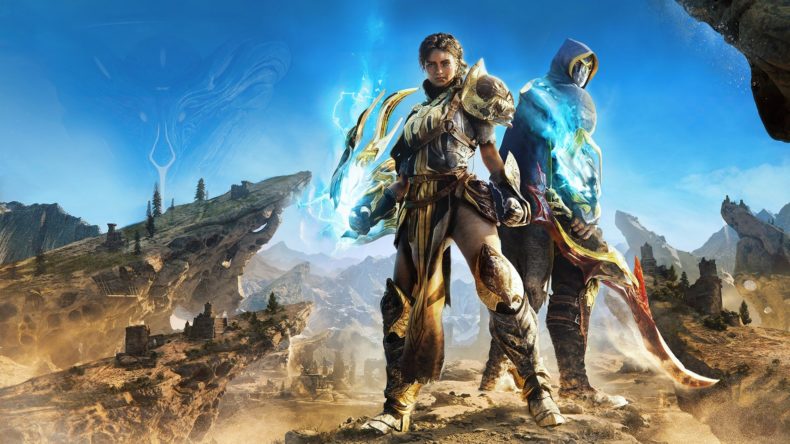August 10, 2023
You ever see one of those cartoons where a guy goes up to a counter to buy a bag of nuts or something and then it turns out it’s not a guy, it’s three raccoons in a trench coat? That’s kind of what Atlas Fallen reminds me of. If you unbuttoned its trench coat you’d have three slightly confused woodland animals each wearing a different sign around its neck saying Story, World, and Combat. You can close the coat again if you want to and pretend it’s all working together, but you’d only be lying to yourself.
The raccoon on the bottom is the game’s world. It’s certainly the part that holds everything else up. The world of Atlas Fallen is an intriguing one. It’s a sci-fi fantasy desert world ruled over by a greedy, capricious god called Thelos, who has enslaved the population and keeps them in thrall using the Watcher, a gargantuan entity that sits ever in the sky, watching the world below.
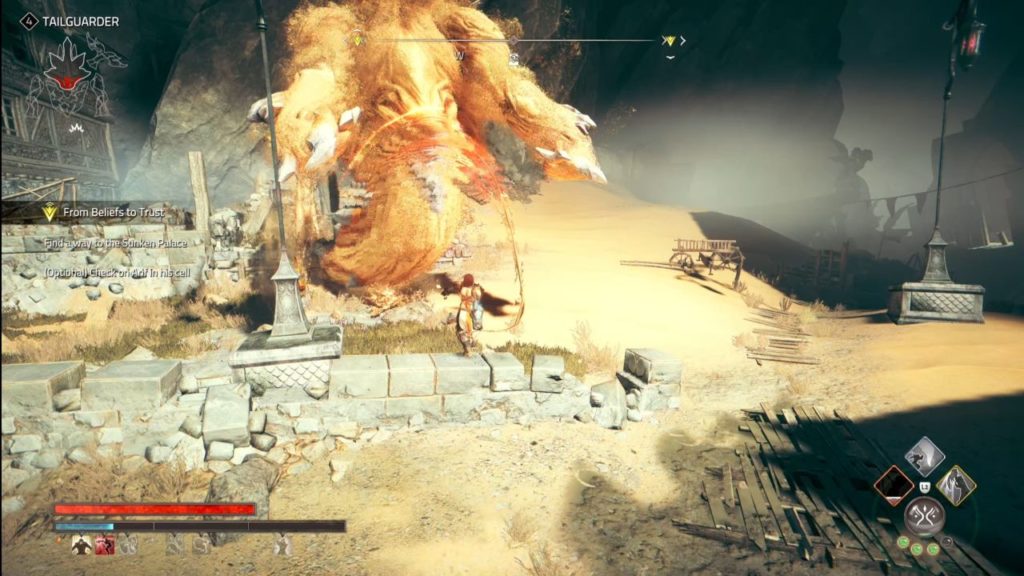
You play as an “unnamed”, a bottom-rung desert dweller scratching in the sand for a living. Until, that is, you find the Gauntlet, a magical artifact with the power to take down the Watcher and defeat Thelos. As a setting it has everything it needs, but in execution there’s a surprising amount of Forspoken in here. From talking wristwear that likes to hold you up for conversation to a huge world that fails to contain much worth exploring, the comparisons are both unflattering and undeniable.
Raccoon number two is Story. It’s doing its best to stay balanced but barely stands a chance of remaining stable. Partly this is down to over-writing, and partly it’s down to a tone that doesn’t know whether to be lofty and epic or drop random Star Wars references all over the shop. It’s not helped by inconsistent voice work and a rambling narrative that’s spread way too thin across such a vast, empty world.
Most of it is tied to the Gauntlet and the spirit trapped within it. Nyaal is such a dry, humourless presence that the chance of chemistry between them and the player-created protagonist is next to zero. NPCs say things with such little conviction that it makes it hard to engage during conversations, and cutscenes are stylised still images with bored-sounding narration.
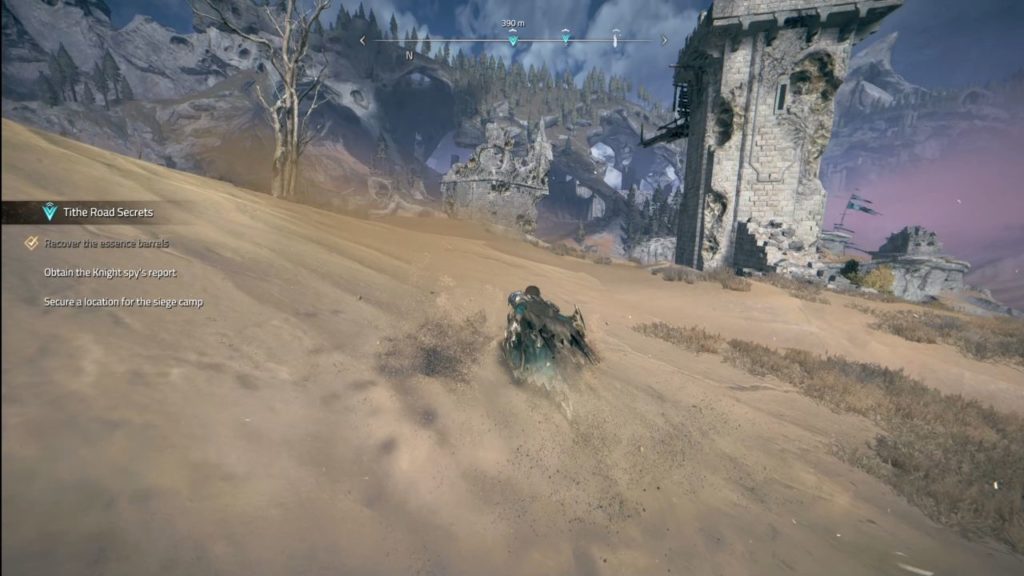
And finally, on top of the pile, peaking out from beneath a grey fedora and trying its best to look like a law-abiding citizen, is racoon number three. See, combat is the face of Atlas Fallen. It’s the flashy bit that’s supposed to sell the illusion, but really it’s just as confused as everything else and has no idea how to play the part. On the face of it, it’s impressive enough, but – again like Forspoken – if you dig deeper it’s just incredibly loud and incredibly messy.
The Gauntlet itself is a cool system. It can shape-shift into three different weapons thanks to its Sandwhip ability. There’s a blade on the end of a chain, a huge hammer, and a pair of fighting mitts. You can have any two of the three equipped at a time, and then you use magical Essence to equip a series of skills, abilities and passive buffs that can be triggered based on your Momentum level. Momentum is earned by dealing damage and either dodging or parrying enemy attacks. At each level (of three) you’ll access the next block of skills and passives, so it pays to fight well and hold your Momentum until you reach level three.
The problem is that Atlas Fallen’s combat is an imprecise, often janky mess. You’re usually dealing with more than one or two enemies at a time, most of which have either ranged attacks or can charge you with little warning. There’s a parry whereby you encase yourself in sand and can freeze smaller enemies, but timing it to block an enemy you can’t see coming is neither easy nor fun to try. Even dropping the difficulty to Easy I found that I was often blindsided, and it’s all so fast and frantic that it never feels like you’re doing anything effective, and instead are just mashing buttons and reacting.
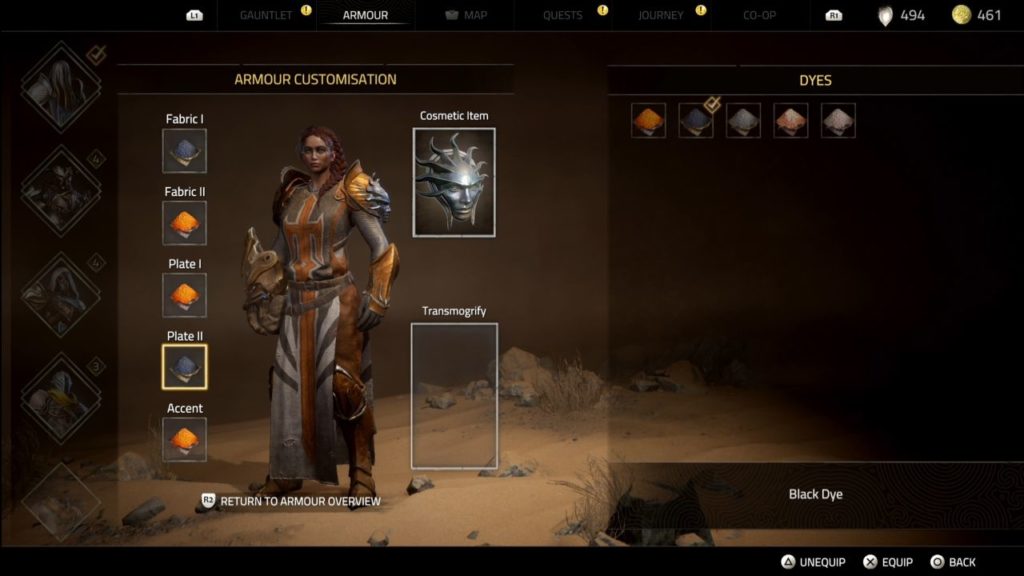
Which is not to say it’s not fun. The combat does have its moments. It’s very flashy, and often looks spectacular, but it lacks any real nuance. You can adjust the Gauntlet loadout, of course, and even save your favourite skill set-up, which does allow for a certain level of tactical play. But the game throws so many skills and abilities at you in such quick succession that I often didn’t realise I had a specific skill for ages after receiving it. And then when I did realise, I found it hard to justify swapping out increased damage or defence for anything else. You can also play through the whole of Atlas Fallen in co-op, and there are many skills and abilities that compliment this. It certainly doesn’t make combat a pushover, but it can make solving some of the puzzles easier and quicker. Exploration is also more fun with a friend, simply because there’s someone to talk to while the game is being po-faced and lofty.
When faced with bosses, you have to destroy their body parts a bit at a time to kill them, which adds an even thicker layer to the wobbly blancmange that is combat. You can target-lock the individual body part, but when you’re zipping around like a pissed-off mosquito, often staying airborne for extended periods of time, it’s hard to keep a sense of weight and distance. Larger enemies can combo you or stagger you, and utilise area of effect attacks as well as damage over time and stuns. It’s a rich cocktail of damage types and attacks, which becomes too much of a muchness when you’re in the thick of it. The engine, too, struggles to keep up and big fights or busy areas tank the framerate. This combined with regular texture pop-in becomes a pretty noticeable issue, especially as every texture is just more sand or sand-coloured stone.
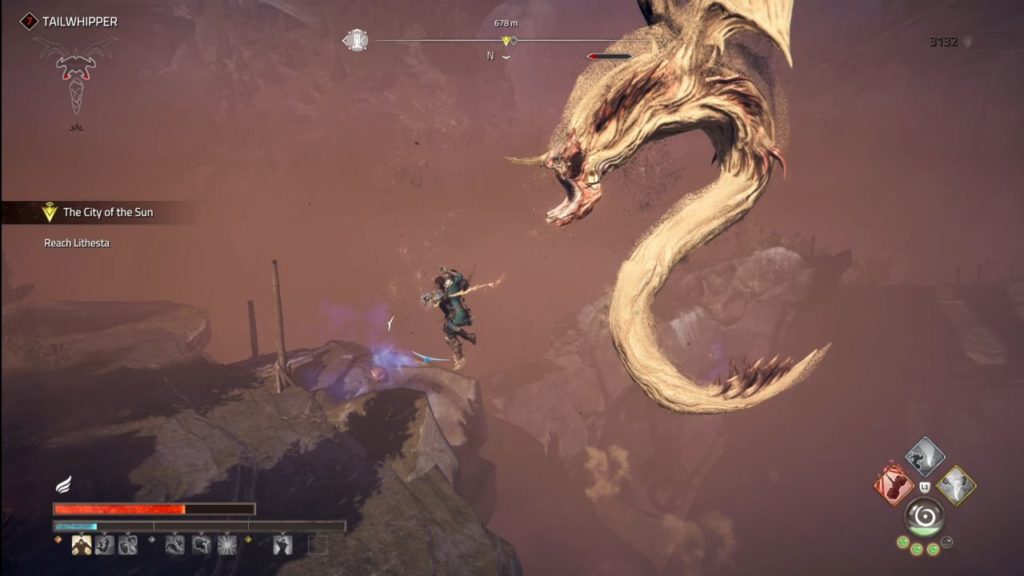
I had more fun between combat encounters, sand-surfing around the world looking for points of interest. The Gauntlet can raise buried items like platforms and chests, or the magical fast-travel Anvils that let you upgrade your Gauntlet, Essence Stones, and armour. Later you’ll receive the ability to crush orange glowing doors and chests. There are puzzles to find and solve, enemies guarding upgrades, and NPCs everywhere offering side quests and odd jobs for money (called “tributes”) or cosmetics with which to alter your armour’s appearance. But there’s so much empty space in between that travel without the Anvil is a dreary process. You’ll spend a lot of time just surfing to places, and it loses its appeal quickly.
Again, there’s also too much going on. The world lacks any real sense of structure. It’s just massive spaces filled with sand and ruins, bookended by settlements that offer merchants and, usually, the next story beat. There’s little sense of direction or design, and you just kind of stumble upon things that are either too densely packed or confusingly explained. For example there are animals marked on the map that you can track and follow to hidden caches, but if they see you they get spooked and run. It’s weird and clumsy and really quite hard to stay hidden, and I could never quite manage to pull it off. Eventually I stopped trying and ignored them.
But there are also idols to smash, timed puzzles to solve, treasure maps to follow, roaming bosses to tackle, and secret upgrades scattered around. It’s not fully open world, but each area is large and populated with secrets and treasures. There’s just too much space in between and little real incentive to hunt everything down as you don’t know if it’s going to reward a new power or another unwieldy, ugly cosmetic you won’t use. It also leans heavily on Nyaal’s ability to highlight important upgrades, but the range is limited and so is how long it lasts. It’ll give you a direction but as he says the same two or three voice lines every time you use it, even that becomes tiresome. It’s all just so much busy work.
Atlas Fallen is not a bad game. There’s a commendable level of ambition here, but it’s let down by some sloppy execution in almost every department. Graphically it’s okay, but enemy design is kind of one-note and each environment is another version of the same desert. One is underground, one is slightly greener, but they’re still big bowls of sand dotted with jutting ruins and glowing lights to investigate. If the combat was a little more precise and impactful, I’d be ready to recommend Atlas Fallen more heartily. The open areas do more harm than good by artificially extending the playtime, but there’s room for completionists to go nuts if they want to.
Ultimately, I find myself coming back to the raccoon analogy. From the outside Atlas Fallen has all the pieces of an open world fantasy epic, but if you look a little more closely you’ll see that it’s really just a hopeful imposter trying its best to get a piece of the action. It’s fun in short doses and there’s potential for fans of flash-bang action adventure, but it’s not quite able to hold it all together when it counts.
Gauntlet system is interesting
Intriguing setting
Messy combat
World feels too big
Forgettable writing
From the outside Atlas Fallen has all the pieces of an open world fantasy epic, but if you look a little more closely you'll see the cracks.


